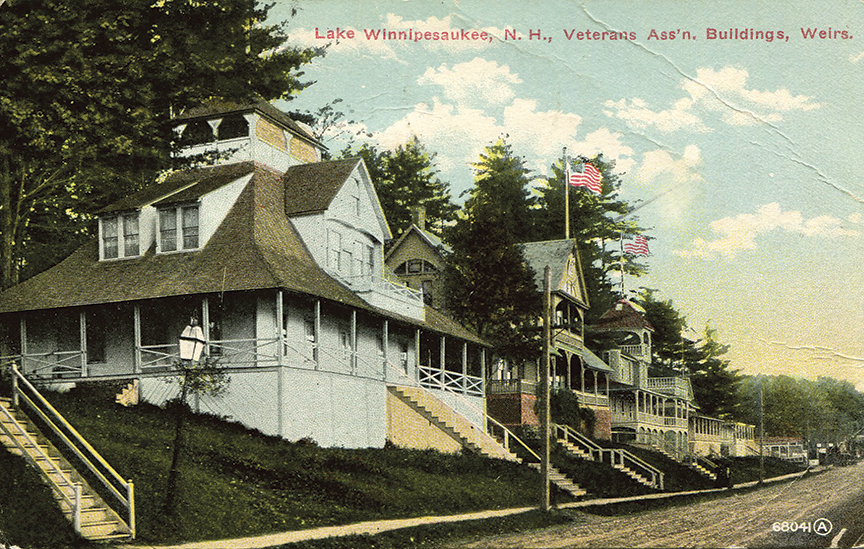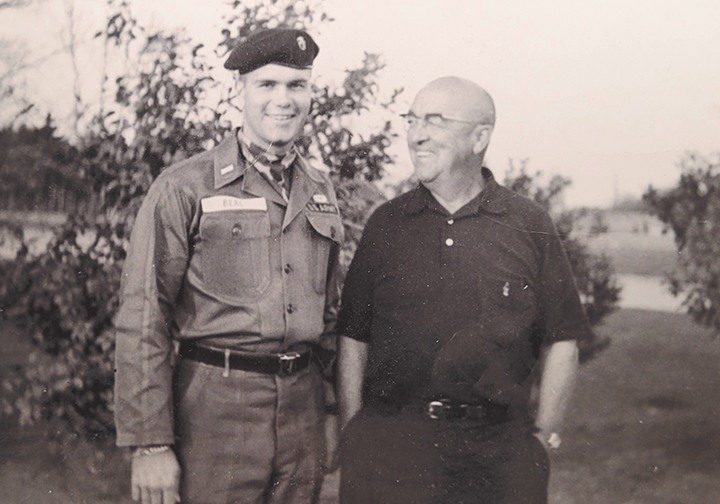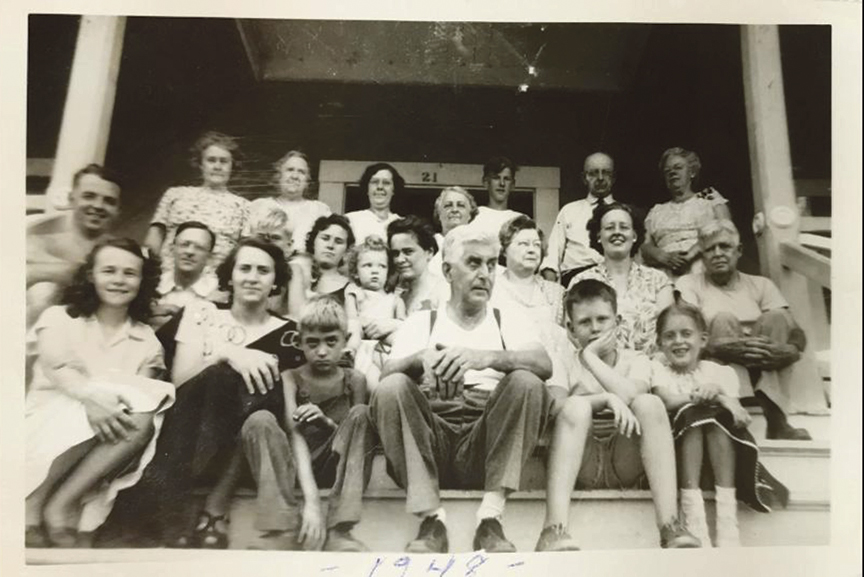The First New Hampshire Calvary Veteran Association To Hold 150th Anniversary

PHOTO: Early postcard showing the Regimental Buildings at the Weirs with the First NH Cavalry Building in the foreground. The First NH Cavalry Veteran Association will be holding their 150th Anniversary in the upcoming week. PHOTO FROM THE PUBLISHER’S COLLECTIONS
by Dwight Mac Kerron
Contributing Writer
The First New Hampshire Cavalry Veteran Association (FNCVA) will be meeting from August 13th to August 20th at the Weirs to celebrate their 150th Anniversary.
The Association first formed in 1870, five years before the New Hampshire Veterans Association was formed and seventeen years before they built their building at the Weirs, which still stands as one of the major historical landmarks on Weirs Boulevard.
The FNCVA has its own website and several Facebook sites. All descendants of men in New Hampshire’s Civil War Cavalry Regiment are eligible to join, and other interested parties may become associate members.

In 2020, the First New Hampshire Veterans Association was about to celebrate its 150th Anniversary of its Civil War veterans and their families to the sixth generation meeting to remember and honor the cavalry’s service in the Civil War, when Covid and skeptical historians intervened. The organization had been celebrating its anniversaries based on information based in recent years on how many years it had been from the 100th, the 125th, etc. When research revealed that NH Civil War Veterans did not form their own association (the NH Veterans Association) until 1875 and did not meet at the Weirs before 1878, several inquiring minds asked how it was possible for our Cavalry Veterans Association to have begun in 1870.
Over time, through the inquiries of member David Kempton and the responses of Civil War historian Steve Dow, information was found of a number of meetings, beginning in 1870, at various New Hampshire sites, which supported the claim that the organization could celebrate its 150th Anniversary in 2020. Mr. Dow subsequently refined his search engines to find references in many New Hampshire publications of the latter half of the 19th Century which show that our organization DID have its first meeting 150 years ago this October at Memorial Hall in Manchester NH.
Steve Dow runs a website honoring the 27th Maine Volunteers, and his search skills of New Hampshire newspapers proved to be invaluable. He found an article from The Farmers Cabinet of Amherst, NH., in January of 1870 announcing that measures were being taken to re-unite members of the First NH Cavalry for the purpose of an annual reunion. Members were requested to contact Captain G. W. Estabrook of Concord, NH.

On September 24, 1870, a notice in the Manchester Mirror and Farmer announced that the Reunion would take place on October 24 at Memorial Hall and all members of the 1st New Hampshire Cavalry and the First Rhode Island Cavalry were invited to attend and free railroad passes, one way, were mentioned.
That first reunion took place, but we, as yet, have no details of it. What we do have are details on the Second Reunion, which took place at Memorial Hall in Concord on November 14, 1871.
The Manchester Mirror and Farmer reports that the meeting was presided over by C. S. Kidder of Nashua and that officers were elected: President-E. H. Smith of Peterboro; Vice Presidents-D. F. Wilson of South Boston, W. W. Durell of Newmarket, and Clarence B. Sanborn of Sanbornton; Secretary and Treasurer- N. P. Kidder of Manchester. Captain W. H. Palmer of Medford, Mass., then read a history of the Regiment, which was received with hearty applause. (Will we ever be able to find that history?) “At one o’clock a hot dinner was served in Angelos Hall. Various members made interesting speeches and the meeting did not break up till train time.”

Twenty-five men attended the Reunion in Nashua in 1872. It was in Dover in 1873 and at Rye Beach in 1874 with about thirty men attending. The Farmer’s Cabinet reports that before the banquet the men told stories, sang songs, and later an address was given by Major Cumming which related relevant statistics on casualties in the war, and Major Cummings was elected President for the following year.
I have found a few references to these men in our history, which was written by Sylvia Lombard. E. H. Smith, who was elected President in the second meeting, eventually became the historian for the Regiment. In an engagement on Nov. 16, near Middleton (Middleburg) Va., called Black Roads, “several men were wounded and twenty captured. Among the captives was Ervin H. Smith of Co. C, who later on became historian for the regiment.” In recounting his captivity years later, Comrade Smith told where he was incarcerated: “Staunton Guard House, Libby (prison in Richmond) two days, Pemberton three weeks, Salisbury, N. C. from December 6, 1864 to February 22, 1865.” One unforgettable experience he said, was “while a prisoner at Salisbury, from a squad of one hundred of whom I was assistant Sergt., 61 died. Cause, exposure and starvation.”
Later in the history, Syl writes: “Ervin H. Smith from Peterborough, had a very active part in those early years and had been an officer, as well as historian, for the Association into the 1900’s. We are indebted to this particular comrade for the brief history that exists of the wartime activities of the Regiment. This is found in the book, Register of New Hampshire Soldiers and Sailors; War of the Rebellion, compiled by Augustus Ayling in 1895. Men from each regiment are listed with a brief history of the battles and campaigns in which their regiments were involved during the Civil War. No official regimental history was ever written for the First New Hampshire Volunteer Cavalry. During December, Lieutenants Palmer and Jones, with fifty picked men, took part in a raid which resulted in the capture of Harry Gilmor, a noted guerrilla.”
In February, when the last move up the valley began, Captain William L. Palmer Co. C, with a small detail of troopers, was attached to General Custer’s headquarters. Because of this arrangement, these men were the only part of First New Hampshire cavalry to be at Appomattox and take part in all engagements with the Third Cavalry Division prior to the surrender of Confederate forces by General Lee.
From this information we can assume that Captain Palmer’s history that he read at the second meeting would have included scenes from the surrender at Appomattox, since he was one of the few men in the Regiment to have been there.
There remains plenty of research to be done, including finding references to other early meetings, beyond what Steve Dow has done. We might consider joining the subscription service, Genealogy Bank, a newspaper subscription site, which he used to find much of the above information and do more research. How many of the names mentioned above appear on our registers and when? Those of us who currently pursue such information, will continue to do so, but others will have to step in over time.
Will you be one of those others?



